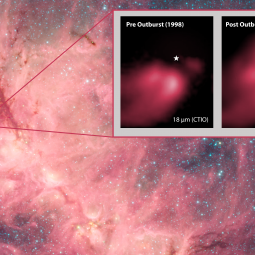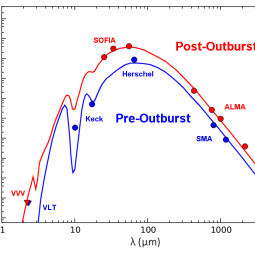By James De Buizer and Joan Schmelz
Paper:
The Extraordinary Outburst in the Massive Protostellar System NGC 6334 I-MM1: Strong Increase in Mid-Infrared Continuum Emission
Hunter, T. R., et al., 2021/05, ApJL, 912, L17.
The realization that protostellar emission can be highly variable began in the 1960s with the recognition that the 6-magnitude optical brightening of FU Ori arose from a young stellar object rather than a nova. Similar scale outbursts have since been found in dozens of low-mass protostars, offering strong evidence that stars form via slow, continuous accretion punctuated by bursts of rapid, episodic accretion of matter from the circumstellar disk. The observed timescales of outbursts span a broad range from several months to a few hundred years.
Episodic accretion may be one of the most important processes in the later stages of star formation, accounting for about 25% of a star’s final mass. While these events are observationally well established in low-mass stars like our Sun, comparatively little is known about the formative years of massive stars. Recent data from SOFIA, however, were crucial in characterizing the brightest and longest-lived accretion burst of a nascent high-mass star.
While monitoring NGC 6334 I, a well-studied proto-cluster, researchers discovered a millimeter outburst from a massive protostar with the Atacama Large Millimeter/submillimeter Array (ALMA). Unlike its proto-cluster companions, this protostar is so deeply embedded that it was only observable prior to the outburst at millimeter-to-radio continuum wavelengths, too obscured to be seen by Spitzer or any other near- or mid-infrared facility.
Using SOFIA’s FORCAST and HAWC+ instruments, the region was revisited after the discovery of the millimeter outburst. The observations revealed that infrared emission from the protostar had also increased considerably. Not only could the protostar now be seen in the infrared, but it was also now the brightest infrared source in the entire proto-cluster.
Combining the fluxes obtained from SOFIA mid- and far-infrared data with ALMA millimeter data, protostellar radiative transfer models were used to determine various stellar properties. Results indicated that the protostar has an outburst luminosity of almost 50,000 L_sun, 16 times higher than the pre-outburst value. The SOFIA data were vital in determining an accurate measurement of this post-outburst luminosity.
A relatively new hypothesis contends that a large uptick in the accretion rate of a massive protostar may be accompanied by the bloating of the photosphere. This not only results in a larger radius but also in a lower effective temperature. This would, in turn, lead to a lower stellar flux of ionizing radiation, a prediction that was confirmed by post-outburst 1.3-cm VLA observations.
Among the most interesting aspects of this protostellar outburst are the remarkably large brightness and longevity. The NGC 6334 I outburst now exceeds all other outbursts by a factor of about 3 in both duration and energy output. These observations show the importance of continuous access to the mid-infrared to enable time-domain studies of the important accretion stage of massive star formation.

